Wood Carvings in English Churches II/Chapter 1
PART I
———
CHAPTER I
STALLS IN CHURCHES OF MONKS AND CANONS
In all churches of monks and canons, whether secular canons or canons following the Augustinian, Premonstratensian, Gilbertine or other Rule, stalls were placed in the choir. These stalls were occupied either by the monks or by the canons and their deputies and by men singers and choristers; there was also a limited lay use. The stalls had seats; these, however, were occupied for but short portions of a service: during the greater part of each service the occupants of the stalls stood or knelt. The seats turned up on a pivot, as may be seen by comparing those of Beverley St Mary (2) with those of Christchurch (2); and when they were turned up, a small ledge underneath the seat gave a little support to any one standing in the stall; for his comfort also there was usually a circular projecting ledge behind him, against which he could lean his back; e.g., at Beverley St Mary, but not at Balsham (3); also he could rest his hands on the shoulders of the stall, when standing, as at Beverley St Mary and Balsham. An elbow was often provided lower down, for use when he was seated; as in the two above-mentioned churches. Above was usually some form of canopy, varying from a cornice of slight projection, as at Balsham, to such tabernacled spires as those of Beverley Minster (27). In front of the stalls, except sometimes the front stall occupied by choir boys, was a desk for service books. Every part of the stallwork was carefully designed; and parochial, collegiate and monastic stalls alike were constantly growing in importance and loveliness up to the Dissolution.
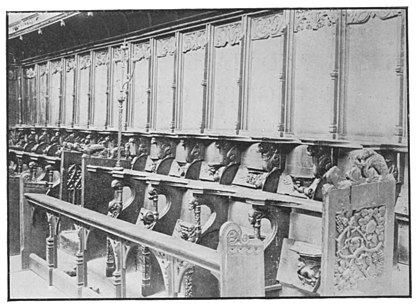
Christchurch

Beverley St Mary's
 Balsham |
 Beverley Minster |
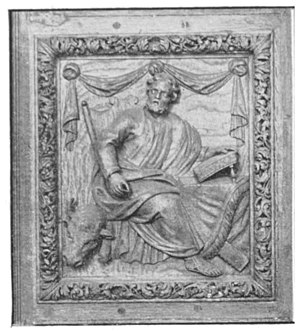 St Luke |
 St Matthew |
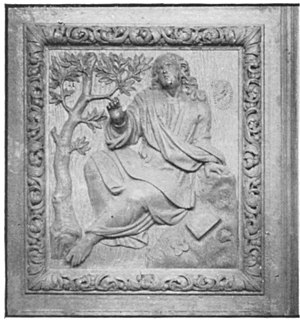 St John |
 St Mark |
Christ Church, Newgate Street

Lincoln
The upper shoulder was usually simply molded, as at Beverley St Mary; it rarely took the form of an animal, as at Balsham. Usually the lower elbow was simply molded, as in Beverley Minster (3); sometimes it terminated in a mask, an animal or foliage; as in the lower range of stalls at Christchurch (2) and at Cartmel (80); in Beverley St Mary there is an angel in front of each of the lower elbows. As a rule, the projecting ends of the elbows were carried down as supports, e.g., at Beverley Minster; sometimes, however, a shaft or pair of shafts is introduced, as at Balsham, Beverley St Mary, Hereford All Saints (44); Dunblane (67) and Christchurch (2), where they are highly enriched. The upper part of the back of the stall is usually panelled; e.g., Winchester (35), Chichester (36). Hereford All Saints (44), Balsham (3). In the sixteenth century, however, panelling became less common; at Dunblane the stall backs are plain (67); at Cartmel they are filled in with scrolls and fretwork (80); at King's College, Cambridge, with coats of arms (78); at Christchurch with carvings of masks and animals (76). In Wren's church at Christ Church, Newgate Street, the panels of the stalls have fine carvings of St Matthew (4), St Mark (4), St Luke (4), St John (4), the Last Supper and other subjects. The desks also usually have traceried panelling in front and at their ends, which is often of much importance in helping to fix the date of the stalls; e.g., at Chester (24), Manchester (6), Trunch (85) and Stowlangtoft (91). At Lincoln the panels of the lowest rows of desks contain alternately the figures of a king and of an angel with a musical instrument (5). On the stall ends was lavished the best artistic talent of the day; there are magnificent examples at Chester (9), Ripon (8) and Beverley Minster (7); very fine also are those in Bishop Tunstall's chapel in Durham castle. On the example from Manchester is an impaled shield, displaying on the dexter half the letters I. B. (i.e., John Beswick, donor of the northern stalls), a cross intervening, and beneath on a chevron seven nails or cloves. The sinister half is occupied by a demi-virgin issuing out of an orle of clouds. The illustrations from Ripon shew the stalls of the Archbishop of York and the Mayor of the city (8). In the former the poppy head takes the form of an elephant holding a man in his trunk, and carrying a castle filled with soldiery; in front of the elephant is a centaur (renewed); below is a large mitre studded with precious stones (mitra preciosa) above a shield charged with the three stars of St Wilfrid, the patron saint of the Minster, and supported by two angels, between whom is a scroll with the date 1494. Attached to the latter is a collared baboon; beneath is a shield charged with the arms of the see of York, two keys in saltire. Of the two examples illustrated from Chester (10), one represents the Annunciation; the other is a most elaborate Jesse Tree (9).

Manchester
The ends of the desks usually terminate in poppy heads; at Chester, Ripon, Manchester and Beverley there are magnificent examples. At Blythburgh, Suffolk (11), is a foliated poppy head with a lion in front; in front of the desks and those on the opposite side of the chancel are niches containing statuettes of the apostles; these stalls were brought into the chancel from the Hopton chapel, which is said to have been founded in 1452; the Hopton arms appear on the bench end. There are interesting desks in the great church of Walpole St Peter, Norfolk (12). When Edmund the King of the East Saxons was shot to death by the Danes and afterwards beheaded, his head was guarded by a wolf; the scene is depicted here and up and down all East Anglia; the whole story is told in six foliated capitals in the north porch of Wells cathedral, which is early in the thirteenth century. At Stowlangtoft, Suffolk, the poppy head consists of a vested priest reading at a lectern or altar (91).

Beverley Minster
Besides stalls for monks, clergy and singers, benches or stalls are sometimes found for members of a church gild, as at Fressingfield, Suffolk; or those now used by almsmen at Etwall, Derbyshire, on which the date 1635 is inscribed; the Jacobean armchair motif is prominent; nevertheless there is Gothic cusping at the back; pegs are thoughtfully provided for the almsmen's hats (13).
 Ripon |
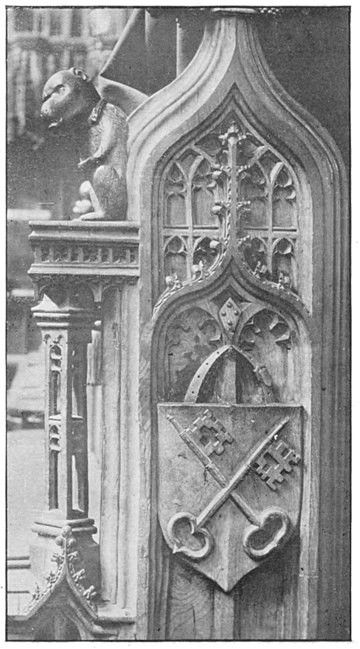 Ripon |
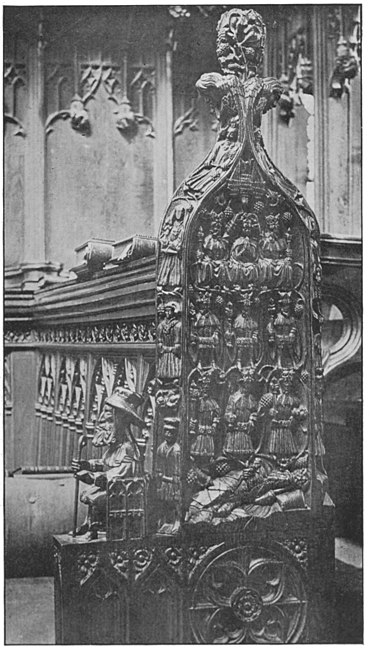
Chester
The stalls are generally constructed very solidly. The ends of a row are inserted in a strong sill, into which the standards for the supports of the book board are also inserted. The elbows are in one solid piece and are framed into the backs of the stalls; they are further secured by the heavy capping above, which admirably connects and strengthens the work. On either side the elbow is sunk to enable the seat to be turned up on its hinges and to afford it support when down. The seats are generally about an inch in thickness, the misericords projecting about five inches. As the entire seat is got out of one solid piece of wood, the time expended on each must have been very considerable; and difficulties in the grain without doubt frequently added immensely to the labour. The work is often cut across the grain and worked with much skill. Great care was taken in some instances to match the wood; e.g., in the panelled backs of the stalls in Henry the Seventh's chapel.[1]
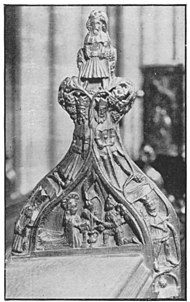
Chester
The construction of the tabernacled canopies is well seen in the set of illustrations from Chester cathedral. In Lincoln Minster, where they are of somewhat simpler type, they may be described as follows. The canopies are hexagonal, supported on shafts, which have clustered niches above their proper capitals; the stalls of the Chancellor and Treasurer, which are at the extreme east on either side of the choir, have winged seraphs in their capitals. The niches have ogee canopies bowing forward in front of their true gables, with various small heads and faces on the hip-knobs. A second story of the canopy contains a niche, square in plan, but set lozenge wise, covered with a lofty pinnacle, and flanked by open screenwork with high flying buttresses, nearly all of which have lost their crockets. All the niches originally contained statues. The loss of these greatly damaged the general effect—the alternation of light and shadow, the play of line and the added mass. Now that the statues have been replaced, the general character intended to be impressed on the design can be well realised (52).[2]

Blythburgh
The cost of woodwork so elaborate as that of the later stalls, especially those with tabernacled canopies, was very great. At Wells the stalls, destroyed in 1848—another example of "restoration"—were begun in 1325; each resident canon paid 30 solidi for his own stall, and the stalls were to cost altogether £1,200. The non-resident canons, having subscribed little or nothing, were ordered in 1337 to make up a deficit of £200 for the completion of the stalls.[3] As the number of stalls needed at Wells would be about sixty, it follows that the expenditure on each stall was to be £20, which in our money might be £300; giving a grand total of about £18,000. The stalls at Amiens number 116, and were put up between 1508 and 1522. Viollet-le-Duc computes that in 1866 they could not have been put up for less than £20,000.[4] But they do not possess tabernacled spirelets, having a comparatively simple horizontal cresting. At Windsor in 1483 six canopies cost £40; thus sixty would cost £400, or in our money about £4,800; i.e., about £80 each; but this expenditure relates to the canopies only, and not to the stalls or the misericords, or the lower stalls and desks; if the cost of these be added, the cost might be as great as at Wells. Few probably realise the vast expenditure which our forefathers gladly undertook not only on the building but the equipment of their churches: in a church of the first rank, such as Exeter cathedral, the cost of the altar, reredos, sedilia, bishop's throne, canopied stalls and pavement would hardly fall short of £30,000 of our money; which is exclusive of the cost of the masonry, vault, timber roof and leading, and stained glass.

Walpole St Peter's
As regards the arrangement of the stalls, as many as there were room for were placed at the back of the choir screen, usually two or three on either side of the western doorway of the choir. The juxtaposition of screen and stalls gives some very beautiful effects, e.g., at Chaddesden, Derbyshire (99); still more so is this the case when screen and stalls are of the same design, as at Chester (24), where the screen was designed in accordance with the stallwork by Sir Gilbert Scott.

Etwall
As to the place of honour in the stalls, that raises some interesting points. There were no less than three places of honour in a chancel; in each case the place of honour was to the right, because it was written in the Psalms, "Sit thou on my right hand"; and because of the words of the Creed, "sitteth on the right hand of God the Father Almighty"; first, the right hand or north side of the altar, facing the west; second, the first seat to the right, or on the south side, of the entrance to the chancel through the choir doorway; thirdly, the extreme right to the east, or nearest the altar, of the south row of stalls. In the sanctuary the Lord Christ was conceived to be in real, corporeal presence, face to face with His people, His right hand to the north, His left hand to the south. In the sanctuary therefore the place of honour was on the north; and to this day when a bishop visits a parish church, his chair is placed north of the altar; the gospel also is read on the north side, the epistle on the south. In several churches in Derbyshire there are stone "gospel-desks" affixed to the north wall of the chancel. Turning to the choir, things are different. When the procession enters the choir from the nave through the screen doorway, the right of the return stalls is the place of honour. Here in a cathedral of the old foundation, i.e., one which has always been served by secular canons, such as Lincoln, Wells, Hereford, the dean sits on the right, and the subdean or the precentor on the left of the gangway. In a monastic church the abbot sat on the south, the prior on the north side. But sometimes a monastic church, e.g., Ely, Winchester, Norwich, was also the cathedral of a bishop, who was ipso facto abbot. In such a church the bishop should sit on the right-hand side of the return stall; at Ely there is no bishop's throne, and he occupies that position to this day.
 Beverley Minster |
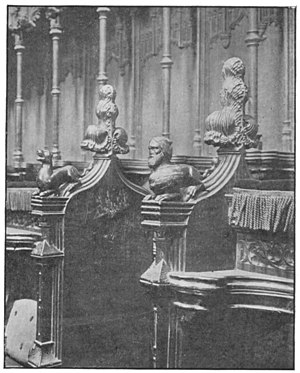 Beverley Minster |
Where a bishop's throne was erected, it was placed on the south side of the choir, which is ecclesiastically always favoured more than the north. Of the stalls on the south side of a choir the one most to the right is of course the easternmost; and it is here that the ancient thrones remain of the bishops of Exeter, St David's and Durham. Again, even if it was not a cathedral church, there were occasions when it was not convenient for an abbot to be so remote from the altar as the return stalls, e.g., at certain portions of the Mass; for such occasions alternative seats were provided for the abbot and prior; the former occupying the easternmost stall on the south side, the prior that on the north. At Peterborough there is evidence that the abbot's seat was on the south, at the east end of the choir, near the ostium presbyterii.[5] At Ripon the bishop occupies the easternmost stall in the south side, which from the carving of a mitre at the back appears to have been originally assigned to the Archbishop of York; the place of honour opposite is occupied by the Wakeman or Mayor of the city.
